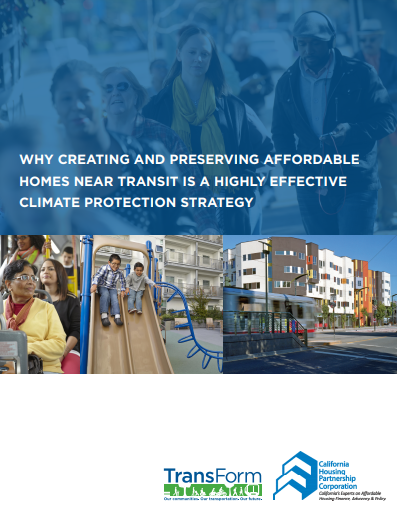Why creating and preserving affordable homes near transit is a highly effective climate protection strategy?

-
Includes:
-
Published
October 2018
California is currently debating how to invest greenhouse gas (GHG) cap-and-trade auction proceeds so that they result in real, quantifiable and verifiable greenhouse gas reductions. A new analysis of data from Caltrans’ California Household Travel Survey (CHTS) completed in February 2013 shows that a well-designed program to put more affordable homes near transit would not just meet the requirements set by the California Air Resources Board (ARB), but would be a powerful and durable GHG reduction strategy – directly reducing driving while creating a host of economic and social benefits. Conducted by the nationally recognized Center for Neighborhood Technology (CNT), the analysis identified 36,000-plus surveyed households that had provided all relevant demographic and travel data and divided them into five income groups, living in three types of locations based on their proximity to public transportation:
-
Transit-Oriented Development (TOD) as defined by the California Department of Housing & Community Development (HCD) requires homes be built within a 1/4 mile radius of a qualifying rail or ferry station or bus stop with frequent service.
-
TOD as defined by the Sustainable Communities and Climate Protection Act of 2008 (SB 375) requires housing to be built within a 1/2 mile radius of a rail or ferry station, or a bus stop but with lesser frequencies than HCD’s definition.
-
Non-TOD areas that do not meet either of these definitions.
Here are two key findings:
-
Lower Income households drive 25-30% fewer miles when living within 1/2 mile of transit than those living in non-TOD. When living within HCD's 1/4 mile of frequent transit they drove nearly 50% less.
-
Higher Income households drive more than twice as many miles and own more than twice as many vehicles as Extremely Low-Income households living within 1/4 mile of frequent transit. This underscores why it is critical to ensure that low-income families can live within 1/4 mile of transit.
In response to soaring demand from Higher Income households for condos and luxury apartment developments near public transit, there has been a surge of new development. The CNT report shows the tremendous greenhouse gas reductions the state can achieve by ensuring that more low-income households can also live in these areas through investment of cap-and-trade auction proceeds.
